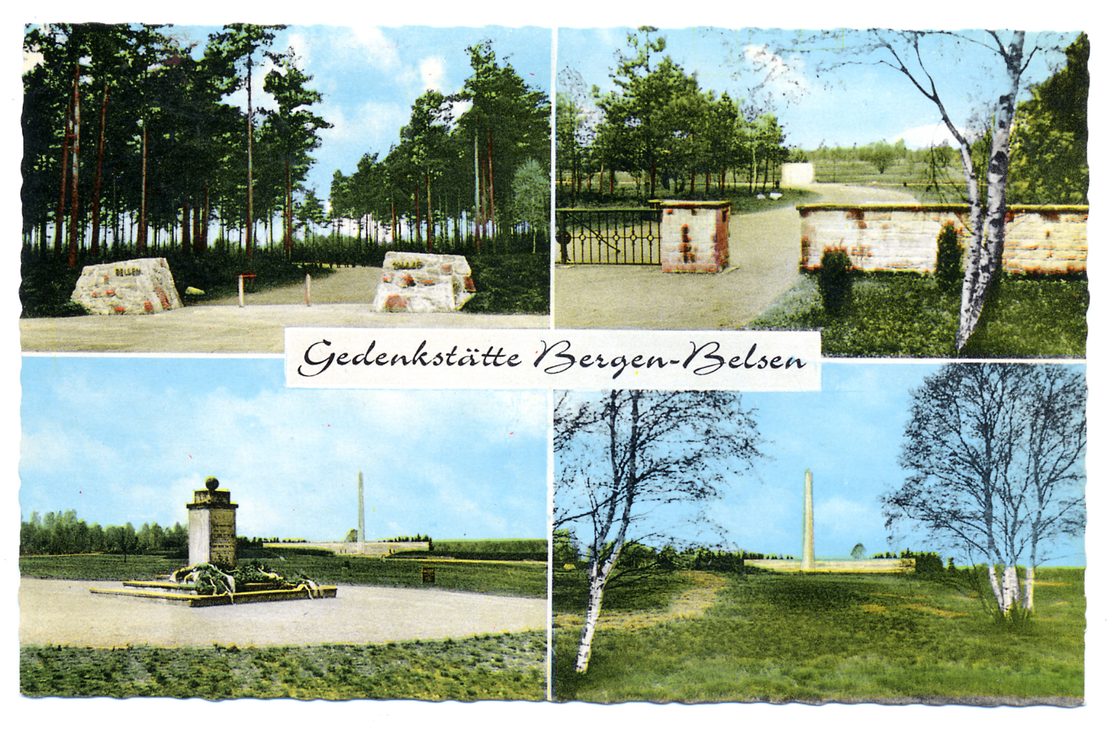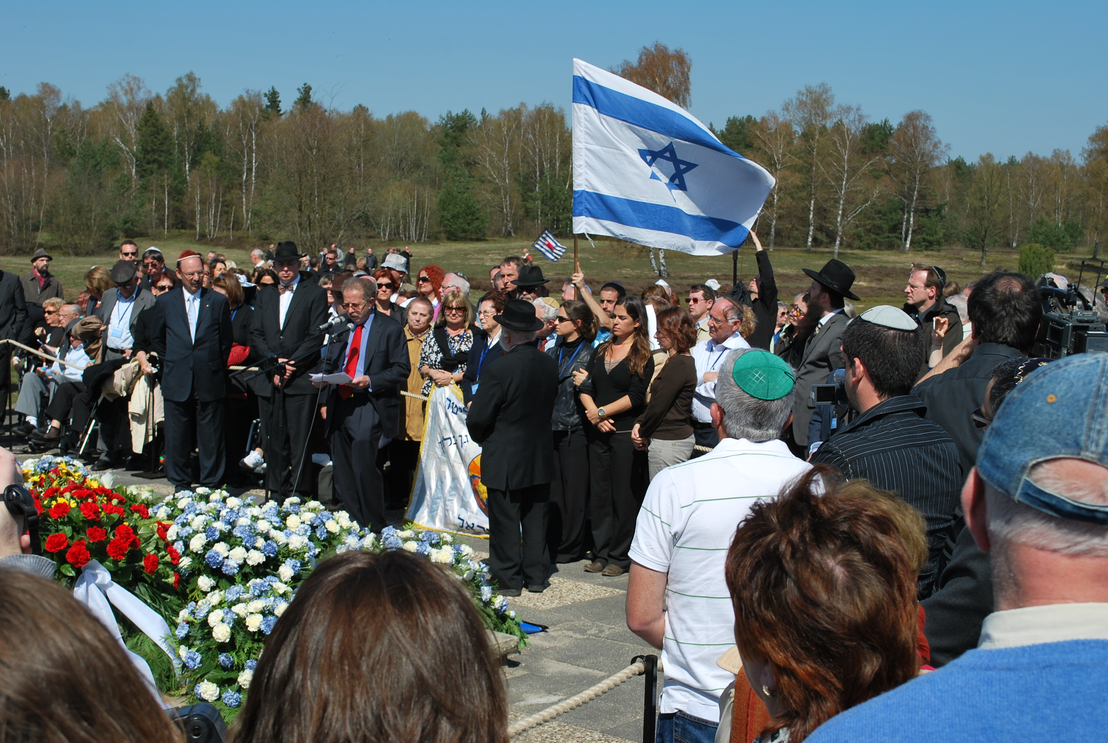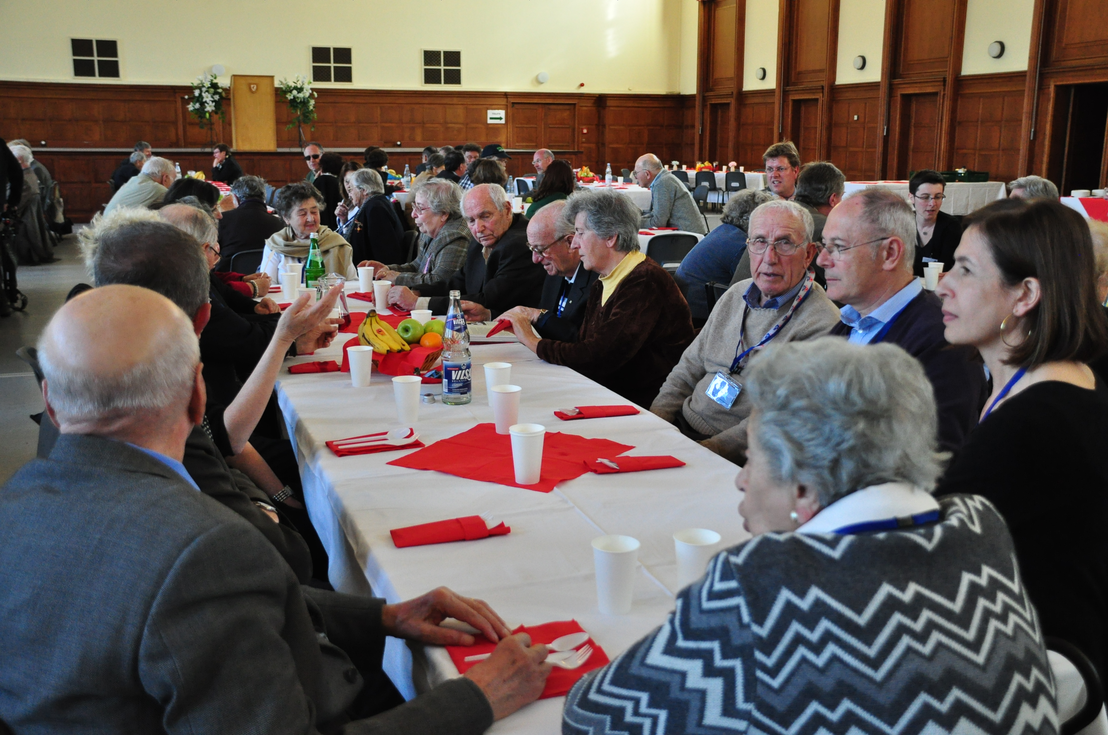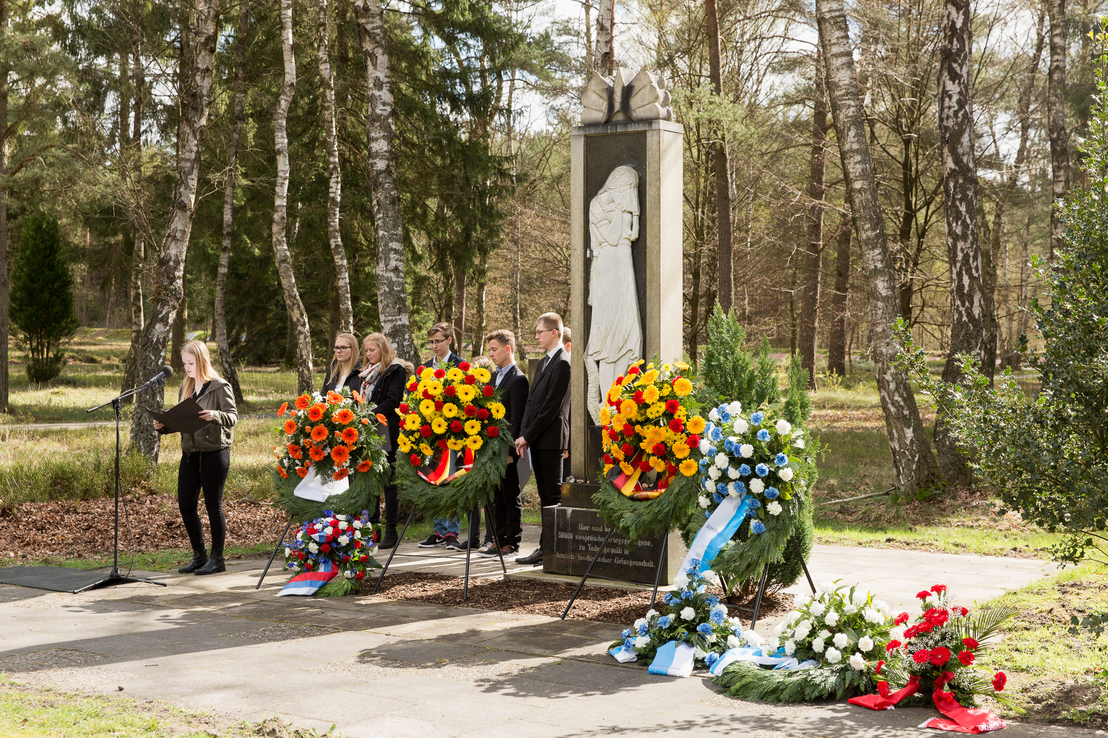A Place of Remembrance
As early as 1945, survivors erected the first memorial stones and monuments in the grounds of the former Bergen-Belsen POW and concentration camp. The Bergen-Belsen Memorial was inaugurated in 1952 after the obelisk and inscription wall were dedicated, and the first Document Building with a permanent exhibition opened in 1966.
For decades, phases of neglect alternated with times of increased attention. Active remembrance was carried out first and foremost by the survivors, who regularly travelled to Bergen-Belsen and organised memorial ceremonies there.
Research and educational work at the Memorial did not start until the late 1980s. New exhibitions opened in 1990 and 2007, and the historical site of the camp was redesigned. Changes to the Memorial have always reflected the changing political and social climate.
-
Commemorative Signs
Commemorative Signs
The first commemorative signs at the site of the former camp were put there by survivors themselves, who placed personal plaques and memorial stones near the mass graves. These were supplemented by large panels with explanatory text in German and English which the British Army installed at the former entrance to the camp shortly after the liberation.
In September 1945, Jewish DPs erected a provisional wooden monument in the grounds of the former camp during the First Congress of Liberated Jews in the British Zone. For most of the Jewish survivors, Bergen-Belsen was not only a place in which to mourn the dead, it was symbolically associated with their political goals at the time: emigration to Palestine and the foundation of the State of Israel. Representatives of the Jewish Central Committee also voiced these demands at the dedication of the stone monument on the first anniversary of the liberation in April 1946.
Not long after the liberation, a Polish camp committee was established in the DP camp with the aim of keeping alive the memory of the Poles who had been murdered. On 2 November 1945, a large wooden cross was dedicated in the former camp in the presence of several thousand survivors as well as representatives of the Vatican and the British military government.
By the end of 1945, the Soviet military mission had erected a monument at the entrance to the Bergen-Belsen POW cemetery dedicated to the nearly 20,000 Soviet victims of the Bergen-Belsen POW camp. A stone monument with name plaques was placed in a separate section of the cemetery for Italian military internees in 1950. This monument was taken down in 1958 when the bodies of the Italian military internees were reinterred in the Hamburg-Öjendorf cemetery.
-
The Memorial
The Memorial
In late September 1945, the British military government ordered the creation of an appropriate memorial at Bergen-Belsen. The resulting plans for a cemetery-like complex only encompassed the area around the mass graves, however. In the summer of 1946, an international commission which included survivor representatives recommended that an obelisk and an inscription wall be erected in the grounds. The Bergen-Belsen Memorial was finally inaugurated in November 1952 with a state ceremony which attracted international attention. Responsibility for the Memorial was then handed over to the state of Lower Saxony, thus making Bergen-Belsen the oldest state-supported memorial in Germany.
During the 1950s, Bergen-Belsen was increasingly forgotten as a place of remembrance. But a wave of anti-Semitic vandalism and a series of high-profile trials of former SS members in the 1960s prompted the Federal Republic of Germany to address its Nazi past. It was within this new social climate that the first academic research into the history of the Bergen-Belsen concentration camp was published, the Document Building and permanent exhibition were opened and the grounds of the Memorial were redesigned.
Even after the Document Building opened in 1966, the Bergen-Belsen Memorial had no permanent academic or educational staff. Two decades later, this state of affairs was no longer commensurate with the extensive research, education and commemoration that was expected to be carried out at sites of Nazi crimes. In 1985, the parliament of Lower Saxony unanimously voted to expand the Document Building and introduce permanent visitor services at the Memorial. A much larger Document Building opened in April 1990, and it included a new permanent exhibition which also covered the history of the POW camp for the first time. From 1987, the Memorial began to hire researchers and educators, build seminar rooms and offer regular tours. This laid the foundation for the ongoing commemorative work at Bergen-Belsen. -
Contemporary Witnesses
Contemporary Witnesses
Bergen-Belsen was a rupture in the lives of the survivors and their families who consciously and unconsciously grappled with their experiences as they moved on after the war. In the 65 years since the liberation of the POW and concentration camps, a diverse culture of remembrance has developed worldwide.
Particularly in the first months and years following the liberation, survivors frequently felt the need to bear witness to, or to collect and safeguard evidence of, the crimes committed by the Nazis. They did so by drawing up lists of survivors and those who perished, by keeping journals, creating documentary artworks and providing witness testimonies. In contrast, some survivors were only able to move forward by largely supressing and remaining silent about the persecution they had experienced.
It was not until their grandchildren’s generation had been born and society had changed that many survivors were able to talk about their suffering. The motivation to address their experiences in Bergen-Belsen often came from external sources such as the Eichmann Trial (1961), the Gulf War (1990) or the death of family members or friends. Remembrance for many survivors therefore also entailed the (religious) commemoration of family members who had been murdered in Bergen-Belsen.
The relevance of political and social developments and the influence of collective cultures of remembrance on individual remembrance gradually became very clear. The development of a country’s culture of remembrance of Bergen-Belsen depended on how important the survivors were to the respective country’s national and political self-image. This can be seen in how survivors and their associations encountered suppression and sometimes even persecution in places like Hungary and the former Soviet Union, in contrast to the national reception of the Shoah in Israel.
Immediately after the war, when the liberated survivors had returned to their homelands or emigrated elsewhere, commemoration focused on honouring the dead by means of monuments and (private) memorial stones. Places for mourning individual victims were created to overcome and compensate for the physical distance to their places of death and their undignified burial in mass graves.
With the passage of time and re-strengthening of anti-semitism in the 1960s, these monuments additionally acted as a warning and a reminder of Nazi crimes. Survivors’ associations arranged for copies of the Jewish monument at Bergen-Belsen to be erected in Jerusalem and Montreal. These memorials also revealed a degree of continuity between the leadership of the Bergen-Belsen DP camp and that of the (Jewish) survivors’ associations in Canada, the USA and Israel.
-
The Redesign of the Memorial
The Redesign of the Memorial
Since 2000, the overall redesign project for the Bergen-Belsen Memorial has been funded by both the state of Lower Saxony and the German federal government. This has made it possible for the Memorial’s staff to carry out research in archives around the world and expand the Memorial’s collection of documents and objects relating to the history of the site. Through several interview projects, the Memorial has amassed an important collection of nearly 400 biographical video interviews with survivors of the POW and concentration camps as well as former inhabitants of the DP camp. The goal of the redesign project at Bergen-Belsen was to establish a Documentation Centre with a new permanent exhibition and to incorporate the entire site of the former camp into the Memorial. The Documentation Centre opened on 28 October 2007 in the presence of many survivors and their relatives. The redesign of the Memorial grounds should be completed by the end of 2011.
The Bergen-Belsen Memorial has received regular funding from the German government since 2009. This annual grant allows it to continue developing its educational programme, among other things.










